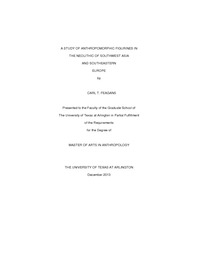
ATTENTION: The works hosted here are being migrated to a new repository that will consolidate resources, improve discoverability, and better show UTA's research impact on the global community. We will update authors as the migration progresses. Please see MavMatrix for more information.
Show simple item record
| dc.contributor.author | Feagans, Carl T. | en_US |
| dc.date.accessioned | 2014-03-12T23:49:20Z | en_US |
| dc.date.available | 2014-03-12T23:49:20Z | en_US |
| dc.date.issued | 2014-03-12 | en_US |
| dc.date.submitted | January 2013 | en_US |
| dc.identifier.other | DISS-12442 | en_US |
| dc.identifier.uri | http://hdl.handle.net/10106/24086 | en_US |
| dc.description.abstract | Anthropomorphic figurines resemble people, very often the people who created them. Thus, these figurines stand to provide insight into their cultures perhaps from the perspective of the original members of the culture. Researchers in figurine studies often speculate on the purposes of figurines and attempt to interpret their meanings. This study attempts to examine anthropomorphic figurines of the Neolithic in Southwest Asia and Southeastern Europe through cataloged and compared physical characteristics of the figurines themselves gathered from published data into a relational database. Figurine data are then imported into statistical software for analysis. The data produced in this study support the early hypothesis that a disproportionate number of figurines are representative of the female sex compared to male. The data also strengthen newer hypotheses that asexual figurines are equally disproportionate. The results reveal trends in representations of sex and suggest perhaps figurine creators may not always have been end users. | en_US |
| dc.description.sponsorship | Petruso, Karl | en_US |
| dc.language.iso | en | en_US |
| dc.publisher | Anthropology | en_US |
| dc.title | A Study Of Anthropomorphic Figurines In The Neolithic Of Southwest Asia And Southeastern Europe | en_US |
| dc.type | M.A. | en_US |
| dc.contributor.committeeChair | Petruso, Karl | en_US |
| dc.degree.department | Anthropology | en_US |
| dc.degree.discipline | Anthropology | en_US |
| dc.degree.grantor | University of Texas at Arlington | en_US |
| dc.degree.level | masters | en_US |
| dc.degree.name | M.A. | en_US |
Files in this item
- Name:
- Feagans_uta_2502M_12442.pdf
- Size:
- 2.713Mb
- Format:
- PDF
This item appears in the following Collection(s)
Show simple item record


